Roofing Companies Blaydon
Find Roofing Contractor in Blaydon
Receive multiple Roofing Services quotes for your project today! Compare profiles, reviews, accreditations, portfolio, etc... and choose the best deal.
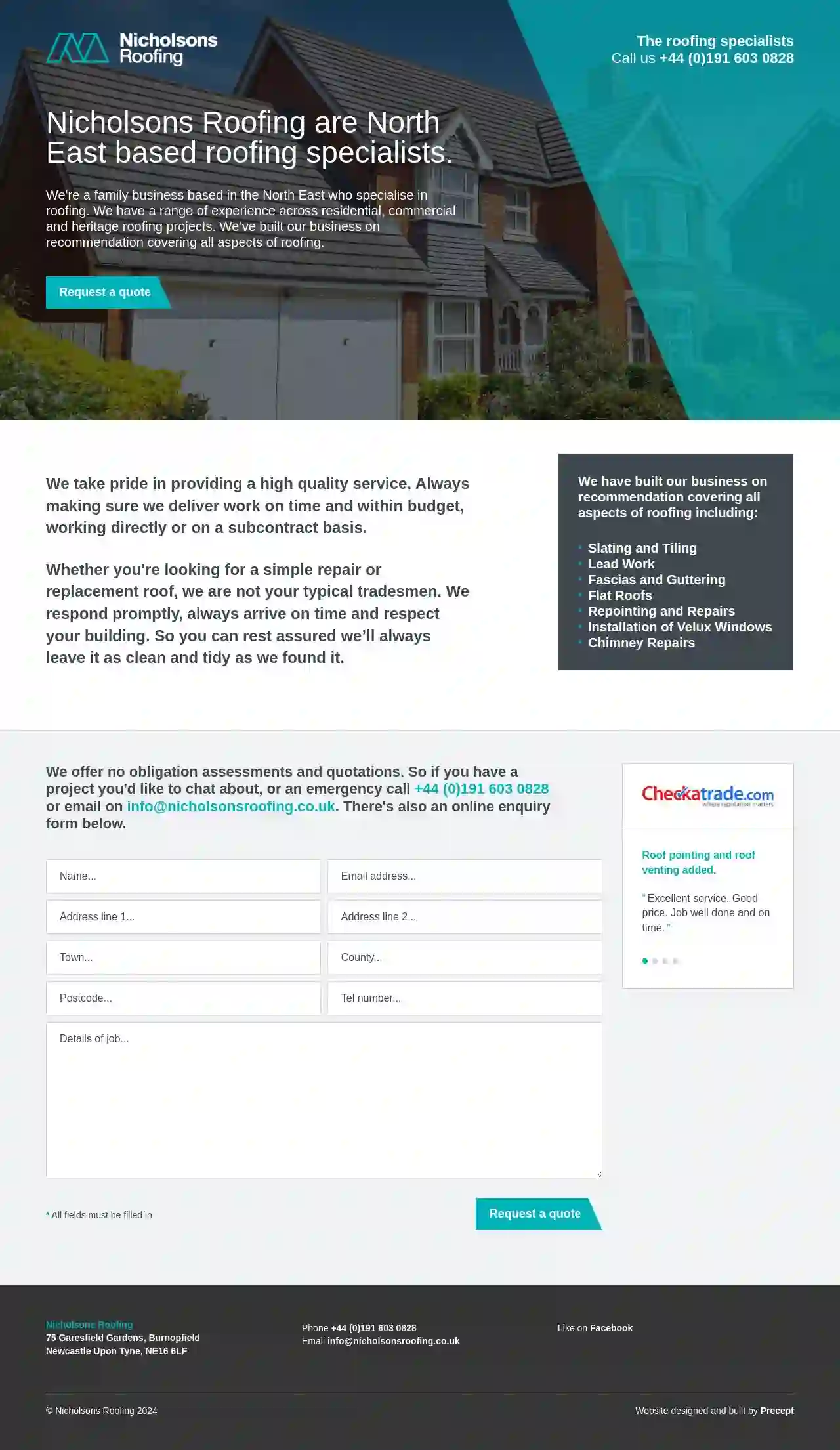
Nicholsons Roofing
3.73 reviews75 Garesfield Gardens, Burnopfield, NE16 6LF, GBNicholsons Roofing are North East based roofing specialists. We're a family business based in the North East who specialise in roofing. We have a range of experience across residential, commercial and heritage roofing projects. We’ve built our business on recommendation covering all aspects of roofing. We take pride in providing a high quality service. Always making sure we deliver work on time and within budget, working directly or on a subcontract basis. Whether you're looking for a simple repair or replacement roof, we are not your typical tradesmen. We respond promptly, always arrive on time and respect your building. So you can rest assured we’ll always leave it as clean and tidy as we found it.
- Services
- Why Us?
- Testimonials
- Gallery
Get Quote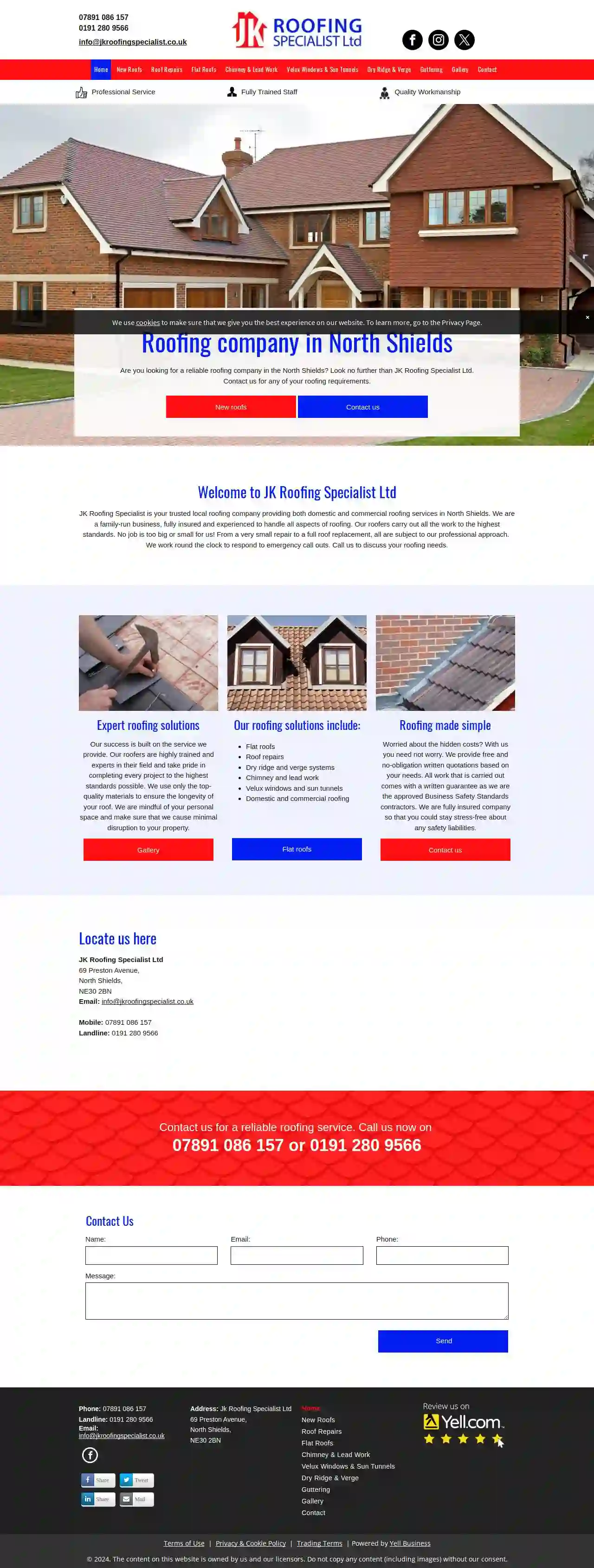
Jk Roofing Specialist
520 reviews69 Preston Avenue, North Shields, NE30 2BN, GBJK Roofing Specialist Ltd is your trusted local roofing company providing both domestic and commercial roofing services in North Shields. We are a family-run business, fully insured and experienced to handle all aspects of roofing. Our roofers carry out all the work to the highest standards. No job is too big or small for us! From a very small repair to a full roof replacement, all are subject to our professional approach. We work round the clock to respond to emergency call outs. Call us to discuss your roofing needs. Our success is built on the service we provide. Our roofers are highly trained and experts in their field and take pride in completing every project to the highest standards possible. We use only the top-quality materials to ensure the longevity of your roof. We are mindful of your personal space and make sure that we cause minimal disruption to your property.
- Services
- Why Us?
- Accreditations
- Gallery
Get Quote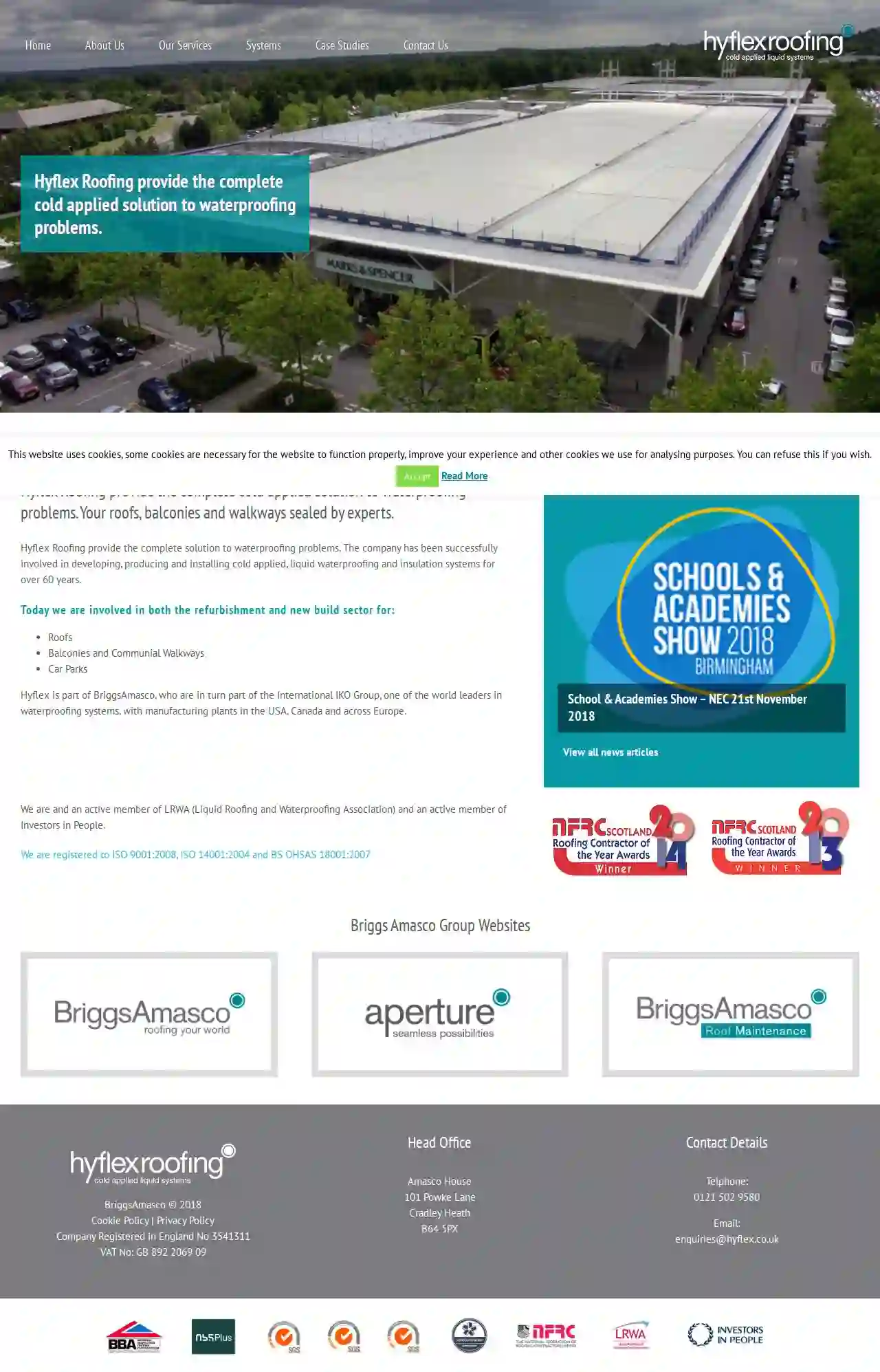
Hyflex Roofing
101 Powke Lane, Amasco House, Cradley Heath, B64 5PX, GBHyflex Roofing provide the complete cold applied solution to waterproofing problems. Your roofs, balconies and walkways sealed by experts. Hyflex Roofing provide the complete solution to waterproofing problems. The company has been successfully involved in developing, producing and installing cold applied, liquid waterproofing and insulation systems for over 60 years. Today we are involved in both the refurbishment and new build sector for: Roofs Balconies and Communial Walkways Car Parks Hyflex is part of BriggsAmasco, who are in turn part of the International IKO Group, one of the world leaders in waterproofing systems, with manufacturing plants in the USA, Canada and across Europe.
- Services
- Why Us?
- Accreditations
- Gallery
Get Quote
R W Quinn Flat Roofing
52 reviewsNorthumberland, 123 Main Street, NE67 5AB, GBNorthumberland Roofing Network is a network of professional roofers providing a wide range of roofing services in Northumberland and surrounding areas. Our members are experienced in both residential and commercial roofing, including roof repairs, flat roofing, guttering, fascias & soffits, and more. We understand the importance of a well-built roof and offer free quotations for all our services. Whether you need a new roof installation, repair, or renovation, our members are here to help. Contact us today to learn more about our services and how we can assist you.
- Services
- Why Us?
- Our Team
- Gallery
Get Quote
Rubberoofs Flat Roofing.
4.830 reviews166 Coatsworth Road, Gateshead, NE8 4LL, GBRubberoofs Ltd was established with the aim of building a roofing company based on traditional values of honesty, integrity, quality, great customer service, and value for money. We boast one of the highest Checkatrade ratings in the UK and are proud to be a trusted roofing company in Newcastle and the North East. Our team of experts is dedicated to providing top-notch services, from flat roofs to pitched roofs, commercial roofing, guttering, fascias, and soffits, chimney works, and roof cleaning. We pride ourselves on our excellent communication, professionalism, and attention to detail, ensuring that our customers receive the best possible service. With years of experience and a commitment to quality, we are the go-to roofing company for residential and commercial properties in the North East.
- Services
- Why Us?
- Testimonials
- Gallery
Get Quote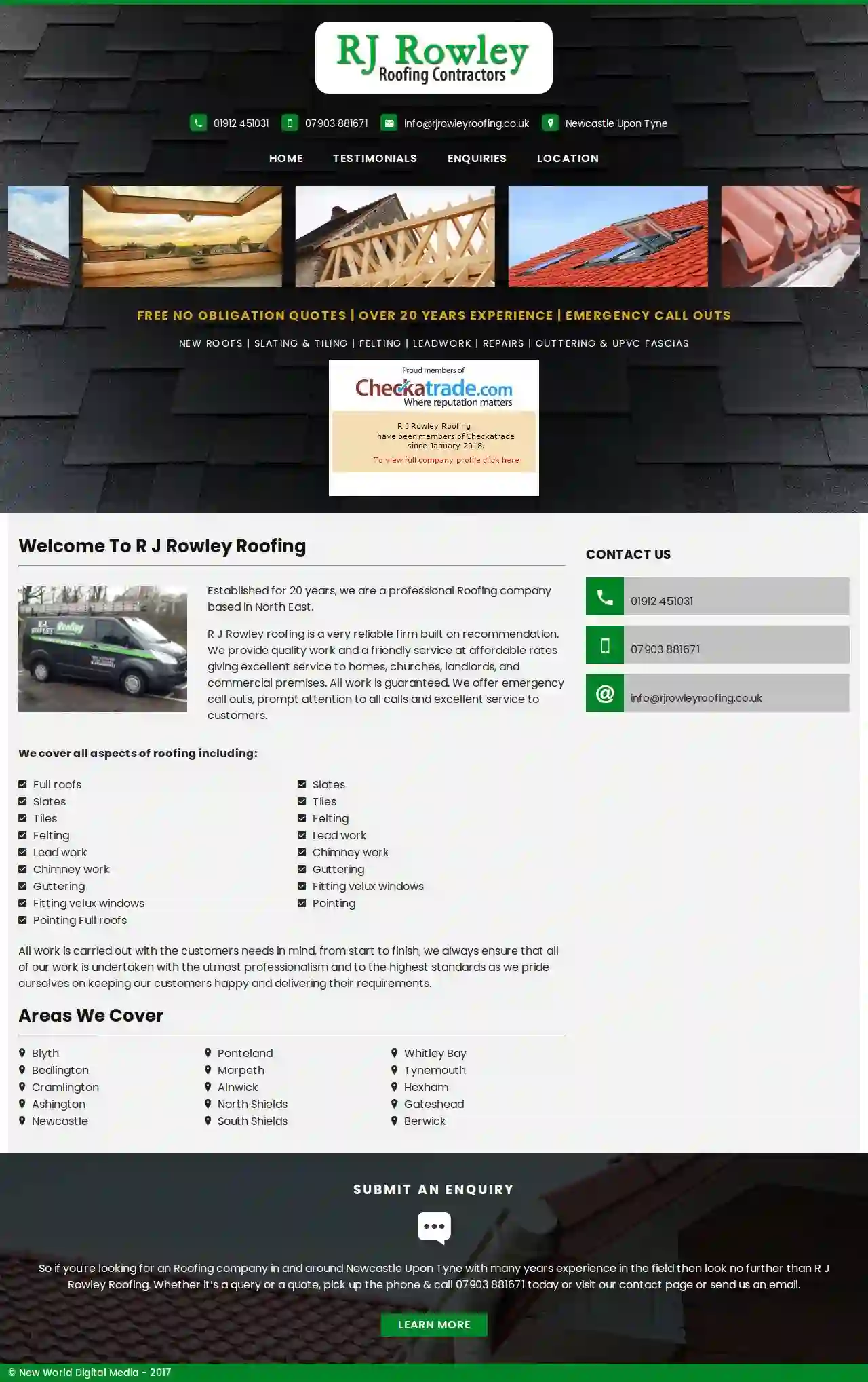
R J Rowley Roofing LTD
4.364 reviews19 Belle Grove West, Newcastle Upon Tyne, NE2 4LT, GBEstablished for 20 years, we are a professional Roofing company based in North East. R J Rowley roofing is a very reliable firm built on recommendation. We provide quality work and a friendly service at affordable rates giving excellent service to homes, churches, landlords, and commercial premises. All work is guaranteed. We offer emergency call outs, prompt attention to all calls and excellent service to customers. We cover all aspects of roofing including: Full roofs Slates Tiles Felting Lead work Chimney work Guttering Fitting velux windows Pointing All work is carried out with the customers needs in mind, from start to finish, we always ensure that all of our work is undertaken with the utmost professionalism and to the highest standards as we pride ourselves on keeping our customers happy and delivering their requirements. Areas We Cover Blyth Bedlington Cramlington Ashington Newcastle Ponteland Morpeth Alnwick North Shields South Shields Whitley Bay Tynemouth Hexham Gateshead Berwick
- Services
- Why Us?
- Our Team
- Testimonials
- Gallery
Get Quote
Aquaproof Roofing Ltd (Newcastle Upon Tyne)
512 reviews21 Parkfield, Seaton Sluice, Whitley Bay, NE26 4HS, GBYour Local Roofer in Whitley Bay With over 15 years’ experience in roofing and property improvement services Aquaproof Roofing is a highly-efficient, reliable roofing contractor providing first class roofing services in Whitley Bay, committed to putting you, the customer, first. We will include you in the full roofing process by giving you the opportunity to view any of the work done by our roofers in Whitley Bay upon its completion, using before and after picture evidence. As part of our high-quality, reliable service we offer a 15 year guarantee with all new roofs we install. We endeavour to deliver on our commitments on time and within budget, using only the best technology, tools and equipment available. We also offer a guaranteed, comprehensive after sales service to answer any questions you may have. About Us Strong Leadership and Experience Aquaproof Roofing is a highly-efficient, reliable roofing company in Whitley Bay. We have become highly successful within the region due to outstanding recommendations received from past clients. We provide cost effective roofing services in Whitley Bay for all your exterior needs. Using the latest equipment our Whitley Bay roofers take pride in their work and strive to provide a service that is professional, reliable and delivered on time. Our promise to you is this: Our roofers are all very friendly and approachable.We promise to try our best to work within your budget where possible. We will go through everything with you regarding proposed work to be undertaken, and only when you are completely satisfied will we commence work.We will do a very professional roofing job and answer all your queries. Our Roofing Services Our company provides comprehensive roofing services in Whitley Bay, using durable and most reliable equipment for installation and repair services. Our projects are valuable to us, and you can expect nothing less than the best.
- Services
- Why Us?
- Accreditations
- Our Team
- Testimonials
- Gallery
Get Quote
Endura Flat Roofing Ltd
548 reviewsNewcastle, GBNEWCASTLE’S EXPERT, PROFESSIONAL, HIGHLY RECOMMENDED RUBBER FLAT ROOFING SERVICE Superior Quality, Longer Lasting, EPDM Rubber Flat Roofers in Newcastle upon Tyne and across the North East QUALITY SERVICEPEACE OF MIND GET A QUOTE → CALL: 0191 2363008 “ I felt that I was in safe hands with people who cared about their work. I would have no hesitation in wholeheartedly recommending Endura Flat Roofing Ltd .”Ruth Draper - Garage & Bay Window Rubber Roof in Heaton, Newcastle. GET A QUOTE → “…the most professional team we have come across whilst carrying out building work. I would highly recommend Endura Flat Roofing Ltd”Mike Ions - Garage, Porch, Rear Extension and Dormer Flat Roofs Replaced, Ponteland - Newcastle upon Tyne. GET A QUOTE → Reliable Flat Roofing Services covering Newcastle & The North East: Garage Flat Roofs: Our EPDM Rubber Flat Roofing system is the perfect system for your garage flat roof. It is the only system that can cover the whole roof in a single sheet - no joints, no seams = NO LEAKS. There is simply no better flat roof membrane for garage roof replacement. GET A QUOTE → CALL: 0191 2363008 Bay Window Flat Roofs: Bay Window Flat Roofs tend to get forgotten until they leak. With our longest lasting EPDM rubber roofing technology you can forget your bay window flat roof for a very long time once you’ve had it replaced by us. 25yr membrane guarantee and a 50yr lifespan. Do it once, Do it right. GET A QUOTE → CALL: 0191 2363008 Flat Roof Repairs: Like everything we do we go the extra mile with our flat roof repairs. We use a tried and tested liquid repair system in combination with re-enforcing scrim and a final protective coating of mineral slate chippings which dramatically increases the service life of the flat roof repair. GET A QUOTE → CALL: 0191 2363008 Insulated Flat Roofs: We have become the go to specialists for insulated flat roofs in the North East. Having been accredited for and participated in the Green Homes Grant Scheme we’ve probably installed more insulated flat roofs than any other contractor in the area. NFRC Competent Roofer, Passive House and Trustmark Certified we have the skills to do it right and provide the Building Control Certificate to prove it. We still have lots more services to add to the website but rest assured if it’s a flat roof we probably do it so just get in touch. GET A QUOTE → CALL: 0191 2363008
- Services
- Why Us?
- Accreditations
- Testimonials
- Gallery
Get Quote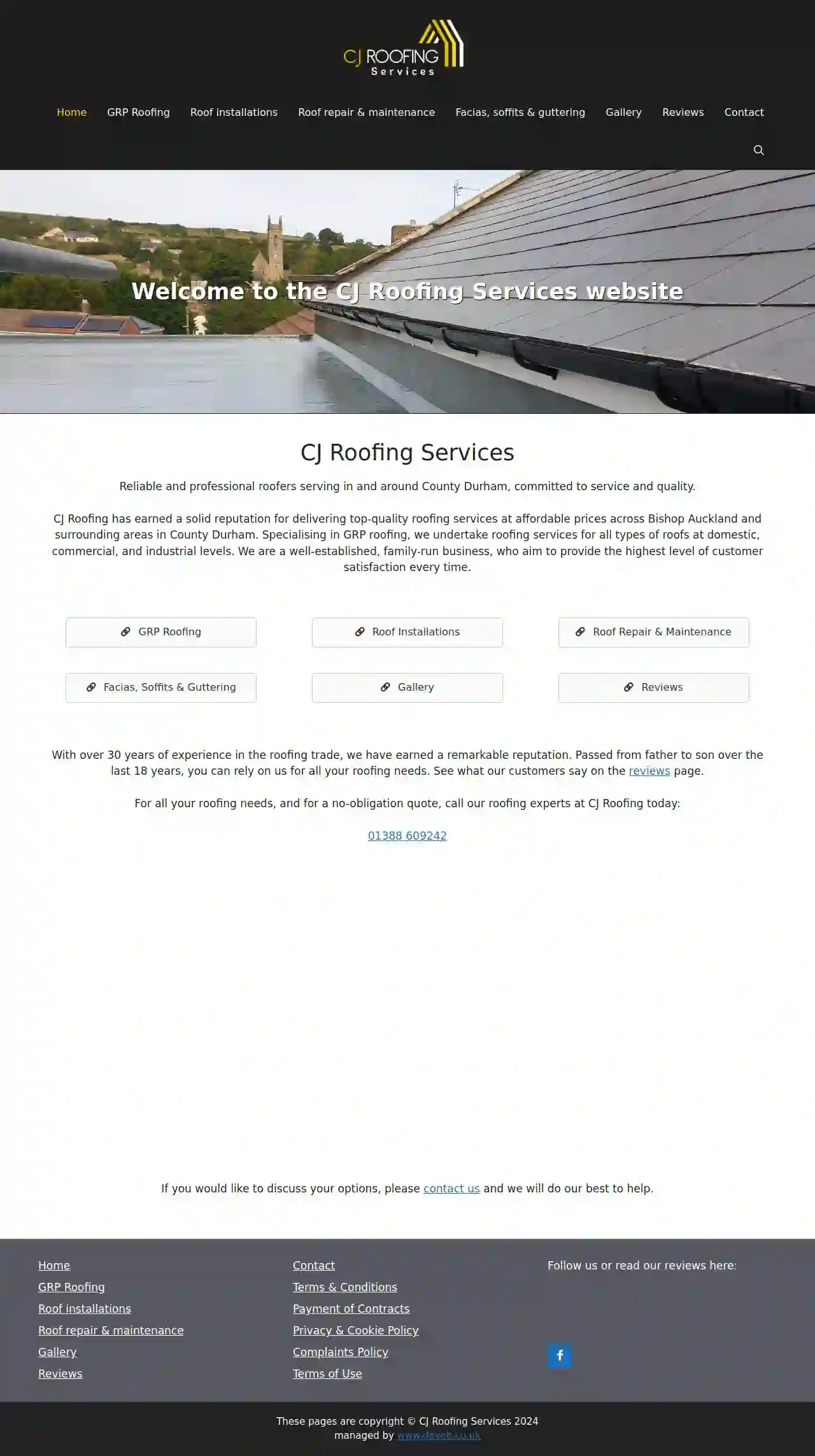
CJ Roofing Services
528 reviewsGBWelcome to the CJ Roofing Services website CJ Roofing Services is a reliable and professional roofing company serving in and around County Durham. We are committed to providing high-quality roofing services at affordable prices across Bishop Auckland and the surrounding areas in County Durham. Specialising in GRP roofing, we undertake roofing services for all types of roofs at domestic, commercial, and industrial levels. We are a well-established, family-run business, dedicated to providing the highest level of customer satisfaction every time. With over 30 years of experience in the roofing trade, we have earned a remarkable reputation. Passed from father to son over the last 18 years, you can rely on us for all your roofing needs. See what our customers say on the reviews page. For all your roofing needs, and for a no-obligation quote, call our roofing experts at CJ Roofing today: 01388 609242 If you would like to discuss your options, please contact us and we will do our best to help.
- Services
- Why Us?
- Gallery
Get Quote
Thompsons Roofing & Lead Specialists
59 reviews15 Cresswell Drive, Blyth, NE24 4QW, GBThompsons Roofing & Lead Specialists are 5* rated roofers based in Blyth, serving Newcastle upon Tyne and surrounding areas. We are experienced in all types of roof installation and repair, from flat roofs to pitched roofs, and everything in between. We pride ourselves on providing a high-quality service at competitive prices. Our team of skilled roofers are fully qualified and insured, and we always strive to exceed our customers' expectations. We offer a wide range of roofing services, including new roof installations, roof repairs, rubber roofs, lead roofs, GRP fibre glass roofs, flat roofs, fascias and soffits, garage roofs, chimney stacks, ridge tiling, roof valleys, and Velux window installations. We also offer free quotes and 10-25 year guarantees on all our work.
- Services
- Why Us?
- Accreditations
- Our Team
- Testimonials
- Gallery
Get Quote
Over 12,314+ Roofing Contractors onboarded
Our roofing pros operate in Blaydon and surroundings!
Roofyng.co.uk has curated and vetted the Best Roofers in Blaydon. Find a trustworthy pro today.
Frequently Asked Questions About Roofing Companies
- Leaks or Water Stains: Water stains on ceilings or walls, dripping water, or dampness in the attic.
- Missing, Cracked, or Curled Shingles: Inspect for damaged or missing shingles, especially after a storm.
- Damaged Flashing: Look for rust, corrosion, or gaps in flashing around chimneys, vents, or skylights.
- Sagging or Uneven Rooflines: A sagging roof could indicate structural problems.
- Granule Loss: Excessive granules in gutters suggest aging asphalt shingles.
- Moss or Algae Growth: Can trap moisture and damage roofing materials.
- Sagging or Pulling Away: Gutters that are sagging, pulling away from the house, or visibly damaged need repairs or replacement.
- Overflowing Water: If water overflows during rain, it indicates clogs or inadequate drainage.
- Visible Debris: Leaves, twigs, and other debris accumulated in the gutters obstruct water flow.
- Water Damage: Water stains or damage to siding or foundation near the gutters suggest overflow.
- Plant Growth: Plants or moss growing in the gutters indicate standing water and the need for cleaning.
- Asphalt Shingles: Popular, affordable, available in various styles (3-tab, architectural, etc.)
- Metal Roofing: Durable, long-lasting, energy-efficient, available in panels, shingles, or tiles.
- Tile Roofing: Clay, concrete, or slate; known for longevity, durability, and aesthetic appeal.
- Flat Roofing: EPDM rubber, TPO, PVC, modified bitumen, or built-up roofing (BUR).
- Slate: Natural stone, extremely durable, expensive, requires expert installation.
- Wood Shakes or Shingles: Natural wood, aesthetically pleasing, requires regular maintenance.
- Ventilation: Soffit vents provide intake ventilation, allowing fresh air to enter the attic and regulate temperature and moisture.
- Aesthetics: It creates a finished look to the roof's underside.
- Pest Control: A properly sealed soffit prevents pests like birds and squirrels from nesting in the attic.
What are some common signs of roof damage?
How can I tell if my gutters need to be cleaned or repaired?
What are the different types of roofing materials?
What is a soffit, and why is it important for my roof?
What are some common signs of roof damage?
- Leaks or Water Stains: Water stains on ceilings or walls, dripping water, or dampness in the attic.
- Missing, Cracked, or Curled Shingles: Inspect for damaged or missing shingles, especially after a storm.
- Damaged Flashing: Look for rust, corrosion, or gaps in flashing around chimneys, vents, or skylights.
- Sagging or Uneven Rooflines: A sagging roof could indicate structural problems.
- Granule Loss: Excessive granules in gutters suggest aging asphalt shingles.
- Moss or Algae Growth: Can trap moisture and damage roofing materials.
How can I tell if my gutters need to be cleaned or repaired?
- Sagging or Pulling Away: Gutters that are sagging, pulling away from the house, or visibly damaged need repairs or replacement.
- Overflowing Water: If water overflows during rain, it indicates clogs or inadequate drainage.
- Visible Debris: Leaves, twigs, and other debris accumulated in the gutters obstruct water flow.
- Water Damage: Water stains or damage to siding or foundation near the gutters suggest overflow.
- Plant Growth: Plants or moss growing in the gutters indicate standing water and the need for cleaning.
What are the different types of roofing materials?
- Asphalt Shingles: Popular, affordable, available in various styles (3-tab, architectural, etc.)
- Metal Roofing: Durable, long-lasting, energy-efficient, available in panels, shingles, or tiles.
- Tile Roofing: Clay, concrete, or slate; known for longevity, durability, and aesthetic appeal.
- Flat Roofing: EPDM rubber, TPO, PVC, modified bitumen, or built-up roofing (BUR).
- Slate: Natural stone, extremely durable, expensive, requires expert installation.
- Wood Shakes or Shingles: Natural wood, aesthetically pleasing, requires regular maintenance.
What is a soffit, and why is it important for my roof?
- Ventilation: Soffit vents provide intake ventilation, allowing fresh air to enter the attic and regulate temperature and moisture.
- Aesthetics: It creates a finished look to the roof's underside.
- Pest Control: A properly sealed soffit prevents pests like birds and squirrels from nesting in the attic.
